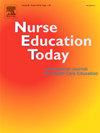提高公平性和包容性:一所护理学校更新着装规范的历程
IF 4.2
2区 医学
Q1 EDUCATION, SCIENTIFIC DISCIPLINES
引用次数: 0
摘要
多样化的医疗保健工作人员可以提高患者护理的质量。护理学校的着装政策既可以欢迎也可以排斥不同的学生。本文描述了一所护理学校修改学生护士着装规范政策的方法,以促进包容和归属感。我们的目的是为护理学校的政策制定者提供一个例子,因为他们正在考虑更新他们的着装规定政策。长期以来,护士着装规范一直存在争议。世界各地的患者对可接受的护理服装和专业精神的看法各不相同。患者同意护理着装规范需要将护士个人识别为医疗团队的一员。然而,正是护士的尊重态度让病人对护士提供安全护理的能力充满信心。专业主义的概念正在从关注外表转向关注行动。严格遵守护理学校的着装规定可能会对学生产生不公平的影响。协同变革。我们描述了中西部一所护理学校的利益相关者用来调整着装规范以欢迎所有学生的考虑因素和合作过程。通过这一合作过程,新的着装规定政策取消了对头发颜色和风格、穿孔和纹身的限制。讨论正式的变化激发了其他以学生为中心的倡议,例如让学生选择灵活的制服风格,扩大制服衣柜以降低成本并促进可持续性。结论护理学校可以从频繁的着装规范审查中受益,以确保安全、公平和受欢迎。通过包容性的着装规范政策,护理学校可以支持所有学生,并为多样化的医疗保健队伍做出贡献,以改善患者的治疗效果。本文章由计算机程序翻译,如有差异,请以英文原文为准。
Improving equity and inclusion: One nursing school's journey to update the dress code
Introduction
A diverse healthcare workforce improves the quality of patient care. A nursing school's approach to dress code policies can either welcome or marginalize diverse students. This article describes one nursing school's approach to revising the student nurse dress code policy to promote inclusion and belonging. Our aim is to provide an example for nursing school policymakers as they consider updates to their dress code policies.
Background
Nursing dress codes have long been contentious. Patients' views on acceptable nursing dress and professionalism vary around the world. Patients agree that nursing dress codes need to identify the individual nurse as a member of the healthcare team. However, it is nurses' respectful demeanor that gives patients confidence in the nurses' ability to provide safe care. The concept of professionalism is shifting from a focus on appearance to action. Strict adherence to nursing school dress codes may inequitably affect students.
Making a Collaborative Change.
We delineate the considerations and collaborative process that one midwestern nursing school's stakeholders used to adapt a dress code to welcome all students. Through this collaborative process, the new dress code policy eliminated restrictions on hair color and style, piercings, and tattoos.
Discussion
The formal changes inspired other student-focused initiatives, such as including students in the selection of flexible uniform styles and the expansion of a uniform closet to reduce costs and promote sustainability.
Conclusion
Nursing schools may benefit from frequent reviews of dress codes to be safe, equitable, and welcoming. Through inclusive dress code policies, nursing schools can support all students and contribute to a diverse healthcare workforce to improve patient outcomes.
求助全文
通过发布文献求助,成功后即可免费获取论文全文。
去求助
来源期刊

Nurse Education Today
医学-护理
CiteScore
6.90
自引率
12.80%
发文量
349
审稿时长
58 days
期刊介绍:
Nurse Education Today is the leading international journal providing a forum for the publication of high quality original research, review and debate in the discussion of nursing, midwifery and interprofessional health care education, publishing papers which contribute to the advancement of educational theory and pedagogy that support the evidence-based practice for educationalists worldwide. The journal stimulates and values critical scholarly debate on issues that have strategic relevance for leaders of health care education.
The journal publishes the highest quality scholarly contributions reflecting the diversity of people, health and education systems worldwide, by publishing research that employs rigorous methodology as well as by publishing papers that highlight the theoretical underpinnings of education and systems globally. The journal will publish papers that show depth, rigour, originality and high standards of presentation, in particular, work that is original, analytical and constructively critical of both previous work and current initiatives.
Authors are invited to submit original research, systematic and scholarly reviews, and critical papers which will stimulate debate on research, policy, theory or philosophy of nursing and related health care education, and which will meet and develop the journal''s high academic and ethical standards.
 求助内容:
求助内容: 应助结果提醒方式:
应助结果提醒方式:


